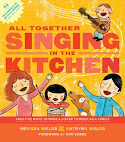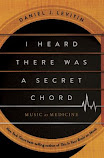Singing Together
I was really missing the feeling of being part of a community singing together in harmony. And I realized that other parents of young children might feel the same way. In fact, there could be people of all ages who might wish for that experience without being able to commit to a choir. So, I decided to start a round singing group here at the Lawrence Branch of the Mercer County Library System. We meet every Monday at 4:15pm, and all are welcome—from babies to retirees. Shakers or scarves are provided for those too young to sing. We learn simple songs like “Row, Row, Row Your Boat” and “I Love the Mountains” through call and response, so no music reading ability is necessary. Once we have practiced a song a few times, we split into groups to sing it. Rounds are special, because multiple groups can sing the same simple tune—but by starting at different times, they create beautiful harmonies.
For the first year of round singing, I was very lucky to have my talented colleague Jen Crabtree as my co-leader. She has since transferred to lead the youth services department at the West Windsor Branch. While we miss her beautiful voice, we are fortunate that another strong singer, Kimberley Halen from adult reference, has stepped in to fill her shoes! Having two group leaders means that it’s always possible for us to split into at least two groups, even if the participants are still learning the songs.
Anyone who has attended one of our round singing sessions or sung as part of another group can tell you that the effects are magical. The combination of stretching our bodies, breathing deeply and rhythmically, and working together to create and envelope ourselves in beautiful sound makes us feel like we’ve just finished a yoga class or a day at the spa by the end of the session. It also makes us feel very warm and connected to each other. But you don’t have to take my word for it—our collection is full of books on the history, techniques, and benefits of singing together. Check out some of the titles below!
Singing with Children
We always love it when families with children come to round singing, but it’s an especially great idea this month, as March is Sing with Your Child Month! Many MCLS branches offer music and movement programs for young children such as Toddler Rock (Hopewell), Romp and Stomp (Robbinsville), and Movers and Shakers (Lawrenceville). Music is often a huge component of our story times, and we frequently invite musical performers such as Ms. Kim and Tim Hoh to share their music with our families. And coming up on Sunday, April 6, the Lawrence Branch will host the Westminster Outreach Choir for a short family-friendly concert and interactive musical game! All of these programs are great opportunities to sing with your child.
Making music promotes family bonding by bringing us into the present moment together; reducing stress and increasing joy; and promoting touch and eye contact. It’s also wonderful for children’s developing brains—it strengthens memory, language skills, executive function, and more. Here are some books from our collection about making music with children:
All Together Singing in the Kitchen: Creative Ways to Make & Listen to Music as a Family by Nerissa Nields and Katryna Nields
This is a warm and accessible guide from musician sisters Nerissa and Katryna Nields - full of songs, games, family anecdotes, and advice on how and why to enrich your family life with music.
The Musical Child by Joan Koenig
This book from music educator Joan Koenig contains more scientific research supporting the benefits of using music with children, but is still very accessible and practical. It also includes stories from her classroom, songs and activities to use with children, and QR codes linking to recordings and tutorials.
You can also check out Jen Crabtree’s 2019 post on this blog, “Baby Dance Party!: The Benefits of Music and Dance for Young Children” for a briefer summary of some of the research on music and child development and a list of her favorite songs and musical props to use with children.
Singing for Health and Wellness
The benefits of singing together extend far beyond childhood--all throughout our lives, in fact!
Music and Mind: Harnessing the Arts for Health and Wellness, Edited by Renee Fleming
Opera singer Renee Fleming curates a collection of essays from a wide variety of today’s leading thinkers studying the health benefits of music and the arts. Of particular interest for us is the chapter “The Potential of Group Singing to Promote Health and Well-Being” by Julene K. Johnson, PhD. Johnson describes a study she conducted with older adults who participated in choirs through senior centers in San Francisco. While cognitive and physical outcomes did not change for those who participated in the choirs versus the control group, they did report “a significant decrease in feelings of loneliness and an increased interest in life…Participants also reported multiple positive emotions associated with singing in the choir. These included happiness, enjoyment, compassion, contentment, optimism, relaxation, peacefulness, unity, gratitude, and awareness of beauty” (p. 304). In another set of studies, researchers from USC found that older adults participating in a choir experienced the same social and mental health benefits described by Johnson, and also increased their ability to perceive speech in noisy environments (p. 462-4).
I Heard There Was a Secret Chord: Music as Medicine by Daniel J. Levitin
In this book, neuroscientist and musician Daniel J. Levitin explores ways in which music therapies can be used to treat a wide range of maladies, from Parkinson’s to PTSD. I was excited to learn that intergenerational choirs are increasingly popular. One study of a choir that paired college undergraduates with older dementia patients found that, after three months singing together, the young singers significantly diminished their biases and discomfort with older adults, while the older participants felt rejuvenated (p. 261).
Music Through History
While the benefits of music are the subject of cutting-edge research today, people have been appreciating them for a very long time. The following books describe how humans have used music throughout history for such varied purposes as building group cohesion; healing ailments; accessing states of altered consciousness and religious revelation; controlling subjects and casting off oppressors; and much more.
The Musical Human: A History of Life on Earth by Michael Spitzer
In this ambitious, interdisciplinary project, musicologist Michael Spitzer demonstrates how and why music has been a constant, fundamental part of the human experience from paleolithic times to the present day. Reviewer David Levitin raves: “Spitzer has pulled off the impossible: A Guns, Germs, and Steel for music.”
Music: A Subversive History by Ted Gioia
In his iconoclastic take on music history, Gioia focuses on the often-overlooked rebels and outsiders who have used music throughout time to drive change and progress.
Song Collections
Now that you’ve learned all about the benefits of singing together, it’s time to experience them for yourself! If you can’t make it to round singing at the library, or want to explore this kind of music further on your own, check out these resources:
Rounds Galore!: Captivating Rounds, Old and New by Sol Weber
This is a collection of 340 rounds with sheet music and human interest stories from Sol Weber, an author and educator who spent decades collecting rounds and traveling the country leading round-singing workshops. You can read more about his life here.
Vrije School Liederen
This website is in Dutch, but many popular web browsers have built-in translation features that make it easy to read in English. In Google Chrome, for instance, you can translate by clicking “English” on the Google Translate pop-up window shown here:
It offers an incredible searchable library of sheet music for music educators, including a huge collection of rounds. If you can’t read sheet music, don’t worry, because each song also includes a midi audio file so you can learn the tune by ear! There is also a lot of wonderful information about the benefits of music education. While the website is meant for music educators, the songs can be enjoyed by people of all ages. You can sign up for a free account to access three songs for free per month, or subscribe for unlimited access.
Thanks for reading, and we look forward to making music with you at the library!
-Molly Reinero, Lawrence Branch, Youth Services












Comments
Post a Comment